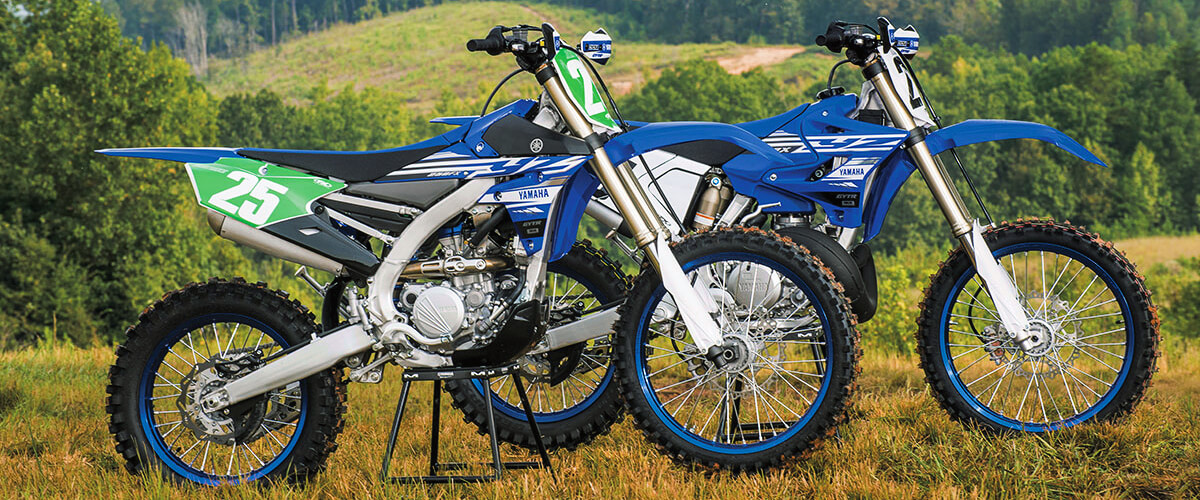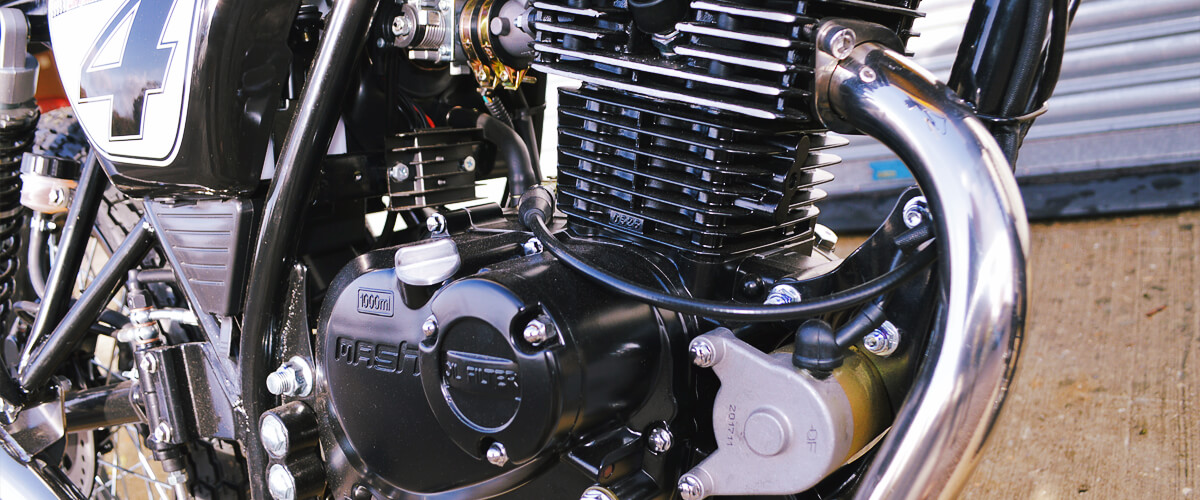The question of which vehicle is better: 2 stroke vs. 4 stroke dirt bike, is one of those age-old ones. This subject tends to stir up quite a bit of buzz, as both types have their passionate supporters.
From countless hours on various trails and tracks, I’ve had the pleasure of riding both 2-stroke and 4-stroke dirt bikes. I’ve loved them, been frustrated by them, and learned a ton along the way. Today, I want to share that knowledge to help you decide which engine type might be your perfect ride.
Brief history of 2-stroke and 4-stroke dirt bikes

The story of the 2-stroke engine begins way back in the late 19th century. Sir Dugald Clerk, a Scottish engineer, introduced the world to the first functional 2-stroke engine in 1878. Over the years, its simple design and high power-to-weight ratio made it a favored choice for many motorized vehicles, including our off-road bikes. They became popular for their raw power and lightweight design, ideal for those thrilling jumps and high-speed rides.
Meanwhile, the 4-stroke engine, or the “Otto Cycle” as it’s also known, has roots that go even further back. In 1867, a German engineer, Nikolaus Otto, patented the 4-stroke design. As the technology evolved, these engines were incorporated into dirt bikes, offering a different riding experience. They gained recognition for their control, torque, and fuel efficiency, making them perfect for technical trails and endurance events.
But the journey hasn’t been a straight path for either engine type. By the early 2000s, 2-strokes were nearly pushed off the dirt bike scene due to environmental concerns. However, with the advent of cleaner technologies and fuel injection systems, they’ve made a comeback, finding their niche once again in the world of off-road biking.
Likewise, 4-strokes have evolved significantly over the years, becoming more powerful and reliable, further blurring the line between the two types.
How 2-stroke engines work
A 2-stroke engine is all about speed and efficiency with just two piston movements (or ‘strokes’): one downward and one upward. These two steps comprise compression and combustion, which happens in one full crankshaft revolution. First, fuel is mixed with air, compressed, ignited, and then the exhaust gases are expelled, all in a lightning-fast sequence.
Now, what makes 2-strokes stand out? Their key advantage lies in their simplicity and power. They’re lighter, easier to maintain, and generally less expensive than their 4-stroke counterparts. Plus, the raw, unfiltered power they offer for their size is unmatched, making them a favorite for racers craving speed and adrenaline.
However, 2-strokes can be louder and less environmentally friendly due to incomplete combustion. They also have a shorter lifespan, consume more fuel, and their power delivery can be tricky to control for beginners.
In the world of off-road biking, 2-strokes shine in motocross and enduro races, where their high power-to-weight ratio and nimbleness allow riders to maneuver with ease and speed. They’re also popular in recreational trail riding for those who love that exhilarating ‘kick.’
How 4-stroke engines work
If the 2-stroke is high-paced, the 4-stroke is all about precision and control.
The 4-stroke engine completes its cycle in four stages or ‘strokes’: intake, compression, combustion (or power), and exhaust. These happen over two full crankshaft revolutions. The steps are more complex than a 2-stroke engine, but this complexity is part of its charm. So, what does 4-stroke mean on a dirt bike? It signifies a smoother, more controlled riding experience.
Why might you choose a 4-stroke? These engines are known for their torque and broader power delivery, making them more manageable, especially for beginners. They’re also more fuel-efficient, quieter, and generally more friendly to Mother Nature. Longevity is another win for the 4-strokes. With proper care, they tend to outlast 2-strokes.
However, 4-strokes aren’t without their downsides. They are heavier due to their more complex design and typically require more maintenance, which can be more expensive. They also lack the raw, punchy power of 2-strokes, which some riders crave.
4-strokes excel in a variety of areas. From motocross and supercross tracks to enduro and trail riding, their steady power output and control make them versatile. They’re also a go-to for long-distance off-road events, where their fuel efficiency truly shines.
Power and performance

Now that we’ve got a handle on how these engines work let’s delve into the fun stuff – power and performance. The way a 2-stroke and a 4-stroke engine deliver their power is where things really start to get interesting.
When we talk about power, 2-strokes deliver a high power-to-weight ratio, meaning they punch above their weight class. This makes them fantastic for quick acceleration and top speeds, offering an adrenaline rush that’s hard to beat. However, their power delivery is more abrupt, which can be a bit too wild for some, especially beginners.
On the other side of the fence, 4-strokes might not have the sheer power of a 2-stroke, but they have something equally important – control. Their power delivery is linear and predictable, making them more manageable in a variety of situations. They also pack a lot of low-end torque, allowing you to navigate tricky terrain more easily. So, you can expect a smooth, controlled ride with the power you can count on when you need it with a bike with a 4-strike engine.
Both engines have their places when considering the type of riding you’ll be doing. For instance, in motocross racing, where high-speed bursts and sharp jumps are the norm, 2-strokes excel. Conversely, a 4-stroke’s smooth power delivery and fuel efficiency are key for long-distance trail riding or endurance racing.
In the end, the choice between a 2-stroke and a 4-stroke isn’t just about power; it’s about how that power is delivered and how it suits your riding style.
Maintenance and upkeep
Just like our own bodies, off-road bikes need regular care to keep them running in tip-top shape. So what should be done to make such an “organism” work clearly and smoothly?
Starting with 2-strokes, they are generally simpler machines with fewer moving parts, which often translates to less complicated maintenance. Common tasks include changing the spark plugs, cleaning the air filter, and maintaining the right fuel-oil mix. However, 2-strokes tend to have a shorter lifespan and may require more frequent top-end rebuilds, which, thankfully, are usually quite straightforward and cost-effective.
On the other hand, 4-strokes, with their more complex design, demand a bit more attention. You’ll need to change the oil regularly, replace the oil filters, and occasionally adjust the valves. While these tasks might be more intricate, a well-maintained 4-stroke can run for a long time before needing a rebuild. But it can be quite costly and time-consuming when they do require major work, like a bottom-end rebuild.
Regarding long-term ownership, here’s a golden rule – preventive maintenance is the key to a healthy motorbike, regardless of the engine type. Regularly checking and maintaining your vehicle not only extends its life but also ensures it’s safe to ride.
Choosing the right engine type

By now, you might wonder, “So, what’s better, 2-stroke or 4-stroke?” Well, the truth is, there isn’t a one-size-fits-all answer. It really boils down to your personal preference, riding style, and what you want out of your off-road adventure.
The difference between a 2-stroke and a 4-stroke dirt bike is more than just how the engine works. It’s about how they feel, respond, and align with your riding goals. So, when choosing between the two, there are a few key factors to consider.
- Think about your skill level. If you’re new to dirt biking, a 4-stroke might be a more friendly companion with its smoother power delivery and control. But if you’re an experienced rider craving raw power and speed, a 2-stroke could provide that adrenaline rush you’re after.
- Consider the type of riding you’ll be doing. For high-speed races, quick jumps, or if you’re just into lightweight bikes, 2-strokes are the way to go. But if you’re more into long-distance trail riding, technical terrain, or endurance races, a 4-stroke’s torque and fuel efficiency could be your winning ticket.
- Mind maintenance. If you prefer simpler maintenance, a 2-stroke might be for you. But if you’re okay with a bit more complex upkeep for a potentially longer-lasting engine, a 4-stroke could be your pick.
Remember, choosing the right engine type isn’t about what’s universally better; it’s about what’s better for you. So take the time to understand what each offers, and most importantly, enjoy the ride.
FAQ
How do I know if I have a 2-stroke or 4-stroke?
If you’re unsure whether your off-road motorbike is a 2-stroke or a 4-stroke, there are a few telltale signs. First, check your fuel. If it’s a mix of gasoline and oil, you’re likely dealing with a 2-stroke. 4-strokes run on pure gasoline. Second, listen to the engine. 2-strokes have a high-pitched, buzzing sound and rev high, while 4-strokes have a lower, throatier sound. Lastly, 2-strokes emit more smoke from the exhaust due to their oil-fuel mix.
Are 2 strokes faster?
In terms of sheer acceleration and power-to-weight ratio, 2-strokes can be faster than 4-strokes. They’re typically lighter and deliver power more abruptly, which makes them great for quick bursts of speed. However, remember that speed isn’t everything. 4-strokes may not match 2-strokes in rapid acceleration, but they offer greater control, torque, and power consistency, which can sometimes translate to faster overall lap times, depending on the track.
Are 2-stroke engines louder than 4-stroke engines?
Yes, 2-stroke engines are typically louder than 4-stroke engines. This is due to their design and the way they operate. A 2-stroke engine fires once every revolution, which creates a high-pitched, buzzing sound. On the other hand, a 4-stroke engine fires once every two revolutions, resulting in a deeper, more muffled sound. It’s worth noting that noise levels can also be influenced by the bike’s exhaust system and the state of its maintenance.






